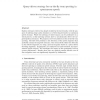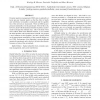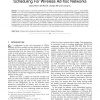832 search results - page 108 / 167 » Effect of Malicious Synchronization |
EJASMP
2010
13 years 4 months ago
2010
Spoken utterance retrieval was largely studied in the last decades, with the purpose of indexing large audio databases or of detecting keywords in continuous speech streams. While...
INTERSPEECH
2010
13 years 4 months ago
2010
It was recently shown that complex cepstrum can be effectively used for glottal flow estimation by separating the causal and anticausal components of speech. In order to guarantee...
ICASSP
2011
IEEE
13 years 1 months ago
2011
IEEE
This paper presents a new acoustic-to-articulatory inversion methodbased on an episodic memory, which is an interesting model for two reasons. First, it does not rely on any assum...
ICASSP
2011
IEEE
13 years 1 months ago
2011
IEEE
Dynamic spectrum management (DSM) aims to optimally allocate per-user transmit spectra so that the effect of multiuser interference (crosstalk) is minimized and the capabilities o...
MOBIHOC
2006
ACM
14 years 9 months ago
2006
ACM
This paper presents a distributed implementation of RAND, a randomized time slot scheduling algorithm, called DRAND. DRAND runs in O() time and message complexity where is the max...



